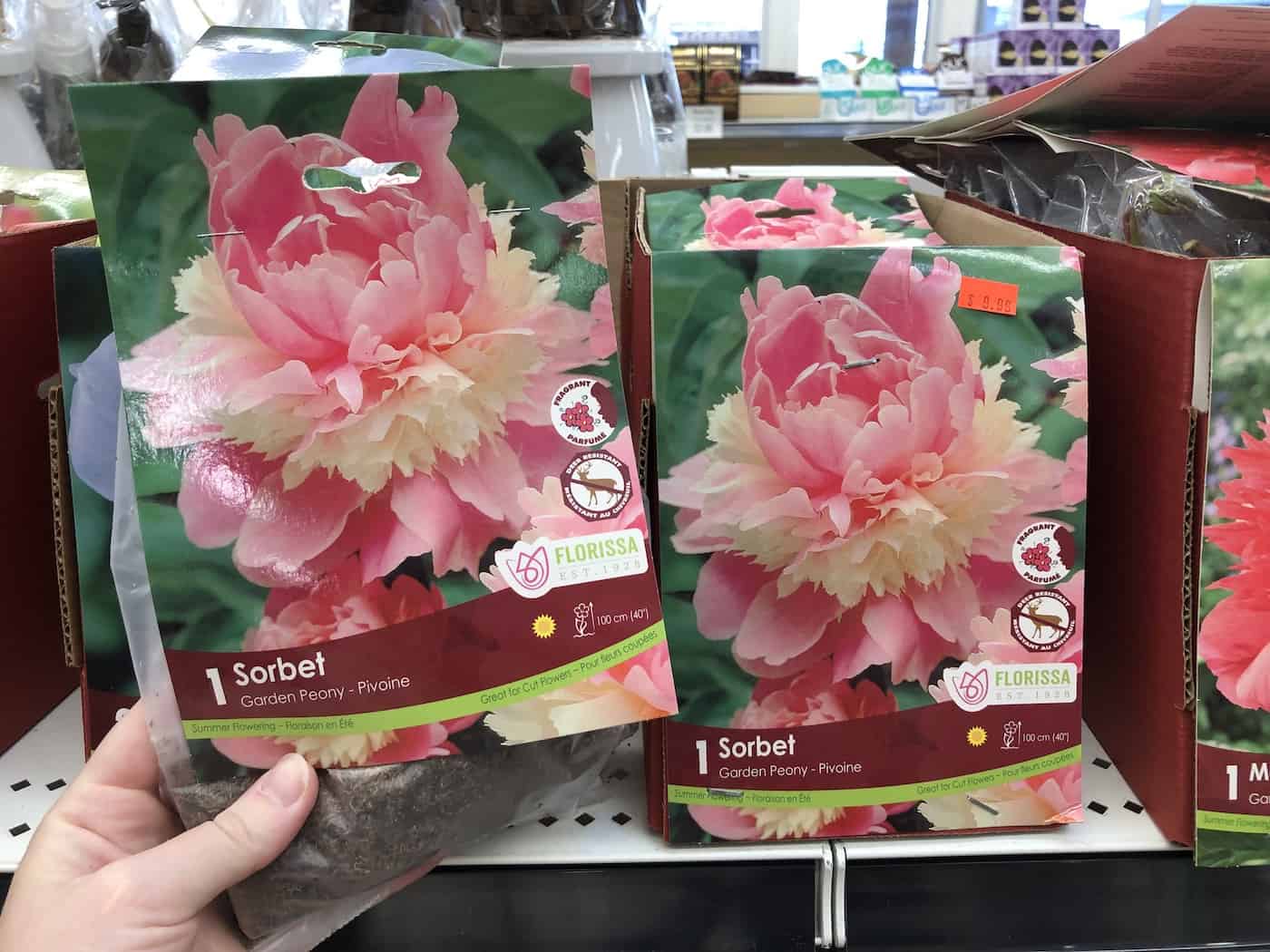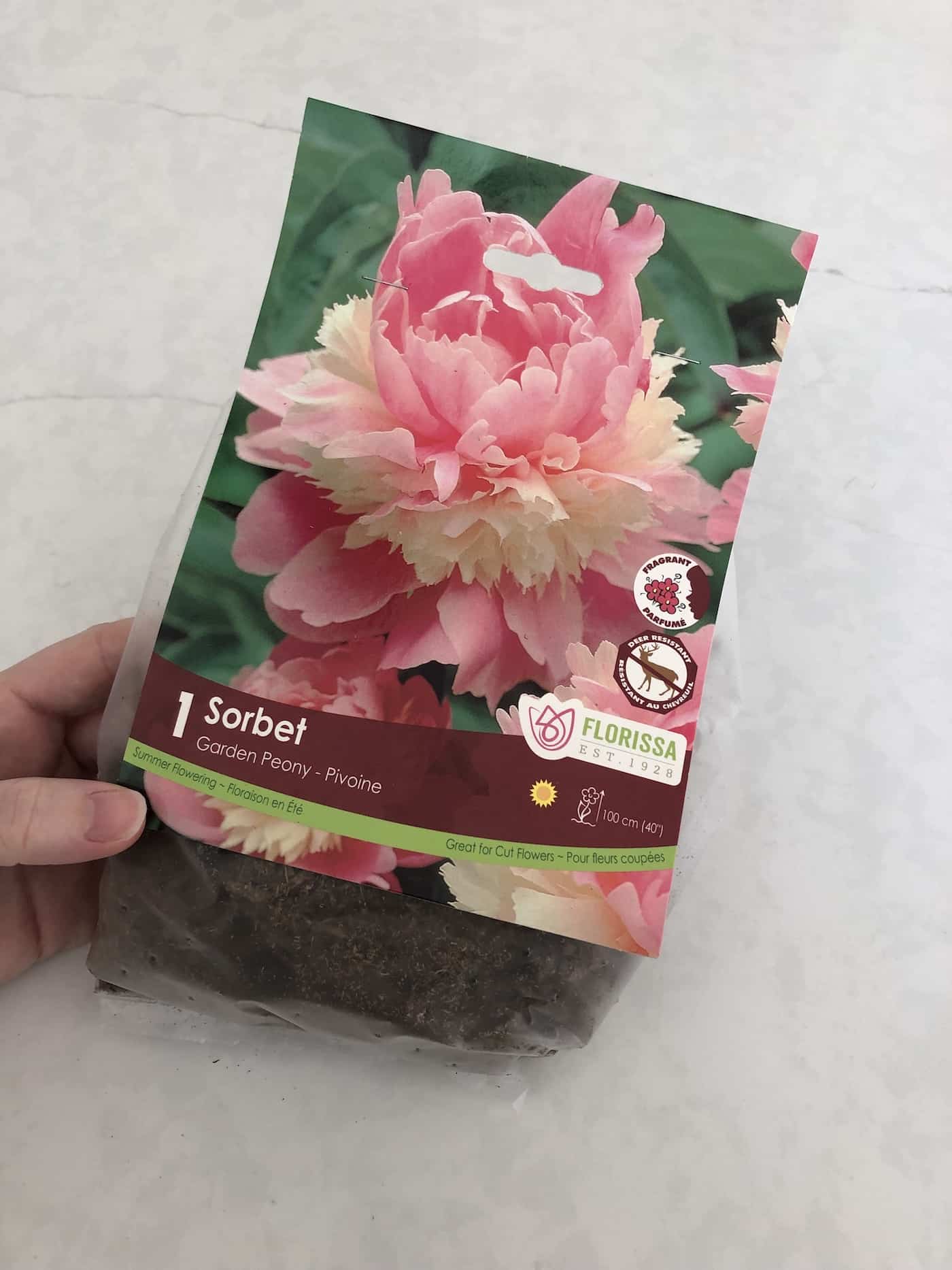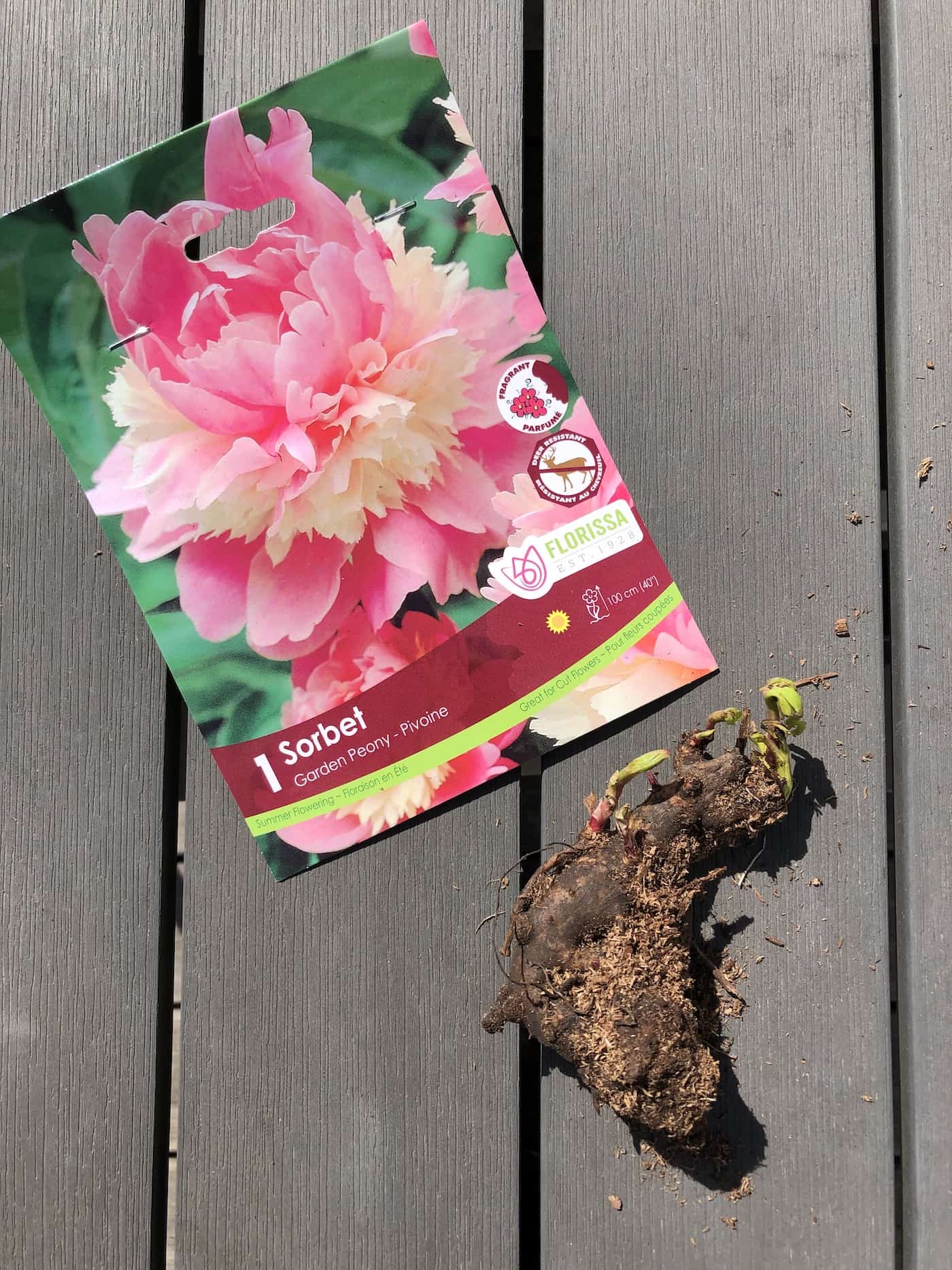Sorbet peony is a pink and white bicolor peony variety known for its fluffy alternating layers of petals. The fragrant “bombe-type” flowers are 6″-7″ wide during the peak of their mid-spring bloom. Plants grow to 26″-36″ tall, with an overall plant width of 24″-36″ wide.
The Sorbet peony was discovered in a South Korean orchard in 1987 by Dutch perennial specialist Luc Klinkhamer. Sorbet peony is a cultivar of Paeonia lactiflora.

Sorbet peony basics
The Sorbet peony is a cultivar of Paeonia lactiflora with alternating layers of pink, white, and cream petals. Sorbet is a herbaceous peony, meaning the foliage dies back to the ground during cold winter weather before sprouting up anew from the roots in the spring. This perennial flower is a favorite in flower gardens in North America, Asia, and Europe. The Sorbet Peony was discovered growing in an orchard in South Korea in 1987 by plant breeder Luc Klinkhamer of the Netherlands.
The flowers of Sorbet Peonies are large (6″-7″ wide) bombe-type flowers with many layers of fluffy petals. The outer petals are pink and are wider than the thinner white petals towards the center. Another layer of pink petals opens up in the very middle of the bloom. Sorbet is one of the most popular of the bicolor peony varieties.
Sorbet peonies tend to bloom in mid-late spring. Compared to other peonies, Sorbet is considered a Mid-Season bloomer.
Sorbet plants do take years to grow to mature size. At full-grown size, the plants are generally 26″-36″ tall and have a width of 24″-36″ across. Despite the name “Sorbet”, peonies are not edible. They are, however, gorgeous, fragrant flowers that would be a wonderful addition to any garden.


Classification
Sorbet peonies (Paeonia lactiflora ‘Sorbet’) are herbaceous perennial plants with bombe-type peony flowers that bloom mid-season.
Peonies come in six main flower types: Single, Anemone, Japanese, Semi-Double, Bombe, and Full Double. Peonies considered bombe-type, like Sorbet, are a special type of double blooms peony in which the outer “guard” petals are longer and wider than the inner transformed petals (although the inner petals do unfurl quite a bit as blooms mature).
Many double blooms look like a fancy dessert, such as a rounded Baked Alaska. Another bombe-type peony named after a dessert is the Raspberry Sundae peony (pictured above in a bouquet with the Sorbet Peony).
Sorbet peonies are herbaceous peonies, so they’re perennials with foliage that will die in late fall. Even though foliage dies back, the roots remain alive while dormant in the earth and will sprout new stems in early spring.

Planting a Sorbet peony in the garden
Sorbet peonies can be planted from potted nursery starter plants or from dormant bare-root peonies. Potted plants are generally available only in spring and early summer, while bare-root peonies can be ordered year-round, with shipping dates generally throughout fall and again in the early spring.
When planting a potted Sorbet peony from the nursery, dig a planting hole that is twice as wide as the width of the pot. The hole shouldn’t be any deeper than the potting soil in the pot. Backfill the hole with the peony and the soil that came out of it. Water the whole area deeply after planting. Cover the soil with a thin layer of organic mulch.
When planting bare-root peonies, dig a hole about a foot wide. Look closely at the root and identify the “eyes” – the white buds on the brown root that will grow upwards and become stems. Most bare-root peonies have 2 or 3 of these white/pink “eyes.” Position the root in the hole so the eyes are at the top, with the eyes facing up towards the sky. The eyes should be about 1″ below the soil surface.
Dig the hole deeper if required, or backfill it with some soil to prop up the root if the hole is too deep. Hold the bare root as you backfill, ensuring the eyes stay about an inch below the final soil surface. Bare root peonies planted with eyes more than 2″ deep may not bloom properly.
Peonies do well with direct sunlight for six to eight hours, so make sure to plant them somewhere in your garden where they’re getting enough sun. Established peonies do well if they’re watered deeply every 1-2 weeks in most conditions.
If you’re planting more than one peony plant, make sure to space them two to four feet apart. The peonies can be planted 2 feet apart in small space gardens, although they might need a bit more attention as the plants grow. If space allows, planting peonies 3-4 feet apart allows each plant to stretch out, allowing the foliage to absorb sunlight and the roots to remain free of neighboring competition.

Growing Sorbet peonies in the garden
Sorbet peonies are easy to grow – especially if they’ve had a good start in the garden. If the newly planted perennials are watered deeply and the soil is kept weeded, the roots will develop into a strong, substantial underground structure capable of withstanding short-term harsh conditions.
Sorbet peonies can benefit from added fertilizer if planted in nutrient-deficient soil. In early spring, apply a thin layer of compost over the soil surface. Later in the spring or early summer, when stems are about a foot high and the leaves are starting to unfurl, apply an organic, slow-release granular fertilizer to the soil around the stems of the plant. Good peony fertilizer options include rose food, bulb fertilizer, perennial flower fertilizer, and bone meal.
Due to their large, heavy flowers, sorbet peonies often need to be staked or supported with a peony ring. The long dark green foliage is generally able to stand up on its own, and some strong Sorbet plants may be able to hold up their blooms, but in windy climates or other less-than-perfect growing conditions, the heavy blooms can easily droop over. Peony rings are especially helpful in exposed growing areas or where spring rain is common.
Sorbet peonies take about two years of growth before they actually form flowers, but it’s well worth the wait. The creamy pastel petals look like they’ve floated right out of a fairytale and can live for over fifty years. While the plants are an investment of both time and money, they continue to pay that back with decades of gorgeous blooms.

Pests and disease
While these flowers resist most pests, it’s important to watch out for honey fungus and peony wilt. Peony wilt is caused by a gray mold, and it’s easy to spot since the peonies will start to wilt. Honey fungus is a white-rot fungus that affects many different plants and is easy to spot. It usually takes the form of a clump of brown mushrooms, and they’ll start to pop up around your plant’s roots.
Sorbet peonies don’t even attract deer or rabbits, so you don’t have to worry about them being eaten up by mammals—or even insects, as they resist most pests as well. The one thing they do attract is butterflies, so if you plant them in your garden, you’ll have a gorgeous flower drawing of gorgeous butterflies.







